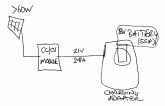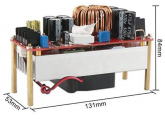I hope this has been posted to the correct forum. I am looking for some advice on what it would take to charge the Ryobi 18v and 40v batteries directly from solar. I do not want to create a system with a bank of deep cell batteries, a charge controller, solar, and an AC inverter (yet). I just wanted to learn what it would take to charge the Ryobi batteries directly from solar. I think the 18v battery is the easiest because Ryobi has created an In-Vehicle charger.
18-Volt ONE+ In-Vehicle Dual Chemistry Charger for use with 12V DC Outlet
https://www.homedepot.com/p/RYOBI-1...ger-for-use-with-12V-DC-Outlet-P131/100342149
I currently have the Nomad 20 which is a foldable solar panel form GoalZero.
https://www.goalzero.com/shop/solar-chargers/nomad-20-solar-panel/
The Nomad 20 has a female 12v car adapter which could connect to the car adapter from the Ryobi In-Vehicle Charger. The specs for the solar output port on the Nomad 20 are 14-22V, up to 1.3A (20W max). They also make a Nomad 50 with 14-22V, up to 3.3A (50W max) and a Nomad 100 with 14-22V, up to 8A (100 max). The Nomad panels are also chainable up to 150 watts.
My first question would be is the 20 watts from the Nomad 20 enough to charge the Ryobi 18v 4Ah battery or would it be better to upgrade to the Nomad 50 or 100…I assume more watts from solar is better? It would be nice if I could get a full charge in 4-6 hours of good direct sunlight.
Next, what would it take to charge the Ryobi 40v battery directly from solar? Ryobi does not make an In-Vehicle charger for their 40v battery so we would have to create something ourselves. If I understand correctly I would need at least 40v+ of solar to be able to charge a 40v battery. I think that means hooking up two 24v solar panels in series so that I get a theoretical total of 48v from the solar. How many solar watts would be appropriate to charge a 40v 5-6Ah battery in about 4-6 hours of good direct sunlight?
Then I thought I would need a charge controller to keep the battery healthy and safe from overcharge, but another forum post said that the Ryobi battery has an internal battery management system (BMS).
DIY Ryobi 18V One+ Power Station (very cool project BTW)
https://diysolarforum.com/threads/diy-ryobi-18v-one-power-station.4229/
Is the internal BMS like a charge controller? If so, can I simply connect the output wires from the solar panels directly to the Ryobi 40v battery? Will its internal BMS kept the battery healthy and safe from overcharge and what about electricity flowing backwards? If that works, I guess the only way to tell the current charge status would be to use the built-in charge indicator on the battery? Would it be safer to use an charge controller?
Any thoughts or advice would be greatly appreciated.
Thanks
18-Volt ONE+ In-Vehicle Dual Chemistry Charger for use with 12V DC Outlet
https://www.homedepot.com/p/RYOBI-1...ger-for-use-with-12V-DC-Outlet-P131/100342149
I currently have the Nomad 20 which is a foldable solar panel form GoalZero.
https://www.goalzero.com/shop/solar-chargers/nomad-20-solar-panel/
The Nomad 20 has a female 12v car adapter which could connect to the car adapter from the Ryobi In-Vehicle Charger. The specs for the solar output port on the Nomad 20 are 14-22V, up to 1.3A (20W max). They also make a Nomad 50 with 14-22V, up to 3.3A (50W max) and a Nomad 100 with 14-22V, up to 8A (100 max). The Nomad panels are also chainable up to 150 watts.
My first question would be is the 20 watts from the Nomad 20 enough to charge the Ryobi 18v 4Ah battery or would it be better to upgrade to the Nomad 50 or 100…I assume more watts from solar is better? It would be nice if I could get a full charge in 4-6 hours of good direct sunlight.
Next, what would it take to charge the Ryobi 40v battery directly from solar? Ryobi does not make an In-Vehicle charger for their 40v battery so we would have to create something ourselves. If I understand correctly I would need at least 40v+ of solar to be able to charge a 40v battery. I think that means hooking up two 24v solar panels in series so that I get a theoretical total of 48v from the solar. How many solar watts would be appropriate to charge a 40v 5-6Ah battery in about 4-6 hours of good direct sunlight?
Then I thought I would need a charge controller to keep the battery healthy and safe from overcharge, but another forum post said that the Ryobi battery has an internal battery management system (BMS).
DIY Ryobi 18V One+ Power Station (very cool project BTW)
https://diysolarforum.com/threads/diy-ryobi-18v-one-power-station.4229/
Is the internal BMS like a charge controller? If so, can I simply connect the output wires from the solar panels directly to the Ryobi 40v battery? Will its internal BMS kept the battery healthy and safe from overcharge and what about electricity flowing backwards? If that works, I guess the only way to tell the current charge status would be to use the built-in charge indicator on the battery? Would it be safer to use an charge controller?
Any thoughts or advice would be greatly appreciated.
Thanks




